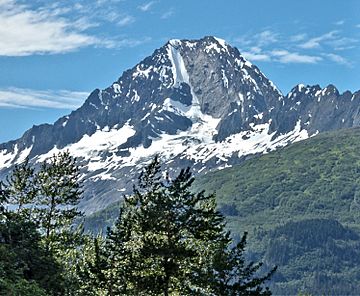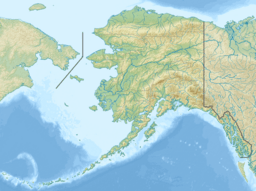Meteorite Mountain facts for kids
Quick facts for kids Meteorite Mountain |
|
|---|---|

Meteorite Mountain, north aspect
|
|
| Highest point | |
| Elevation | 6,565 ft (2,001 m) |
| Prominence | 2,965 ft (904 m) |
| Isolation | 8.9 mi (14.3 km) |
| Parent peak | Mount Benet |
| Geography | |
| Location | Valdez-Cordova Borough Alaska, United States |
| Parent range | Chugach Mountains |
| Topo map | USGS Cordova D-6 |
Meteorite Mountain is a tall, glaciated mountain peak in Alaska, United States. It stands about 6,565 feet (2,001 meters) high. This impressive mountain is part of the Chugach Mountains.
You can find Meteorite Mountain about 16 miles (26 km) southeast of Valdez. It's also about 9 miles (14 km) south of Hogback Ridge and 9 miles (14 km) southeast of Mount Francis.
The mountain got its unique name because a meteorite hit it in January 1927. People in the area were already using the name "Meteorite Mountain" before it was officially published in 1953 by the U.S. Geological Survey. Water from the mountain's glaciers and rainfall flows into streams that feed the Lowe River. This river eventually empties into Prince William Sound.
Understanding the Climate at Meteorite Mountain
Meteorite Mountain is located in a subarctic climate zone. This means it has very long, cold, and snowy winters. The summers are usually cool.
Weather systems often come from the Gulf of Alaska. When they reach the Chugach Mountains, the air is forced to rise. This process is called orographic lift. It causes a lot of rain and snow to fall on the mountain.
Temperatures on Meteorite Mountain can drop very low, sometimes below −20 °C (−4 °F). With the wind chill, it can feel even colder, below −30 °C (−22 °F). The best time to visit or climb the mountain is usually from May through June. During these months, the weather is often more pleasant for outdoor activities.


